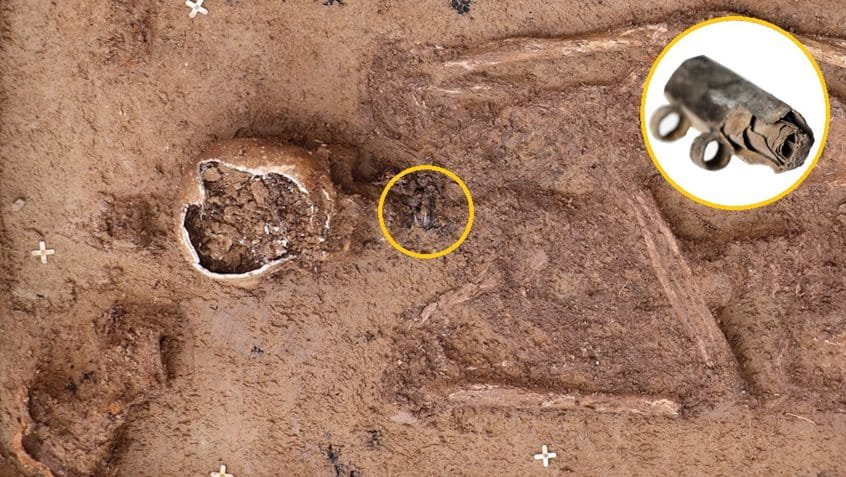Unveiling History: The 1,800-Year-Old Silver Amulet of Frankfurt and Its Implications for Early Christianity

The 1,800-Year-Old Silver Amulet of Frankfurt
Introduction to the Discovery
The recent discovery of an extraordinary 1,800-year-old silver amulet in Frankfurt, Germany, has captivated both archaeologists and historians alike. Unearthed from a grave, this amulet has prompted an extensive reevaluation of early Christian objects and their significance in ancient society. The meticulous conditions under which the amulet was found lend credence to its historical importance. Archaeologists documented that the silver object was placed in the grave right next to the chin of the deceased male individual, indicating its potential role in burial rituals or spiritual practices of the time.
This remarkable finding not only sheds light on the material culture of the Roman Empire but also raises profound questions about the early Christian context in which such artifacts were used. Silver amulets, often inscribed with protective prayers or symbols, served as personal talismans and revealed the spiritual beliefs and practices of individuals during a formative period in history. The placement of this amulet is particularly noteworthy, suggesting that it may have held special significance for the deceased. Furthermore, the grave’s excavation revealed that the amulet retained its shape and detail remarkably well, providing scholars with vital information about the craftsmanship and aesthetics of that era.
The age of the amulet further amplifies its significance, as it predates many known Christian artifacts, positioning it in the early stages of the faith’s development. This timeframe corresponds with a period of intense change and integration of beliefs across cultures in ancient Europe. As experts continue to analyze the nuances of this discovery, it is anticipated that a deeper understanding of early Christian influences on metalwork, spirituality, and burial practices will emerge, inviting further exploration into the complex tapestry of early Christian history.
Details of the Amulet
The recently discovered silver amulet of Frankfurt, dating back approximately 1,800 years, stands as a remarkable testament to early craftsmanship and artistry within the realm of ancient religious artifacts. Measuring about 5 centimeters in diameter, this beautifully fashioned piece exhibits intricate designs that reflect the cultural and spiritual beliefs of its time. Weighing around 30 grams, the amulet is crafted from a high-quality silver alloy, which indicates both the skill of its maker and the value placed on such items in the early Christian community.
One of the most striking characteristics of the amulet is its detailed engraving, which showcases a blend of geometric patterns and symbolic motifs. The craftsmanship is indicative of a highly skilled artisan who not only understood the technical aspects of metalwork but also had a deep comprehension of the theological significance embedded in the designs. Each line and curve is meticulously crafted, highlighting both aesthetic beauty and spiritual depth. The symbolism suggested by its motifs implies a connection to early Christian iconography, providing insight into the beliefs and practices of the community that utilized this amulet.
The Inscription: A Closer Look
The remarkable 1,800-year-old silver amulet discovered in Frankfurt is adorned with an intricate inscription, comprised of 18 lines of Latin text. This delicate etching not only showcases the craftsmanship of the time but also serves as a vital source of information about early Christian beliefs. The Latin inscription is a combination of prayers and invocations, reflecting the faith and spiritual practices of the individuals who wore it.
Upon translation, the text reveals a profound connection to early Christian ideologies, incorporating themes of protection and divine aid. The overall tone is one of supplication; the prayers are directed towards a higher power, imploring for safety and health. This focus on personal devotion suggests that early Christians may have adopted amulets as a significant part of their religious practice, using them as tangible symbols of their faith. The presence of such an inscription on silver, a precious material, underscores the importance of religious artifacts in asserting one’s beliefs and identity.
Moreover, the language used within the inscription provides insights into the sociocultural dynamics of the period. The Latin employed is reflective of the early Christian community, suggesting a blend of traditional Roman expressions with emerging Christian motifs. This indicates a transitional phase in religious practice, where ancient customs intertwine with the growing influence of Christianity. Analyzing the text can also elucidate more about the geographical context and the exchanges occurring between diverse cultures during this epoch.
In examining the inscription further, scholars can debate its implications for understanding early Christian values, the intersection of religion and community, and the evolution of spiritual identity during a time of significant transformation in the Roman Empire. The silver amulet, therefore, is not simply an artifact; it is a key that unlocks the complexities of faith and society in antiquity.
Historical Significance of the Amulet
The recent discovery of a silver amulet dating back 1,800 years in Frankfurt has profound historical significance, particularly concerning the early development of Christianity within the Roman Empire. The amulet features an inscription that may provide substantial evidence for the existence of Christian beliefs during a time that has traditionally been viewed as pivotal for the faith’s evolution. Archaeologists and historians are examining its contents to understand better how early Christians lived and practiced their faith in a predominantly pagan society.
This amulet stands out as a unique artifact that could potentially rewrite parts of the narrative surrounding Christianity’s emergence in the Roman Empire. Historically, scholars have debated the timeline of Christian adoption and the nature of its followers amidst widespread polytheism. The amulet’s inscription not only sheds light on the beliefs held by its owner but also suggests the possibility of a more entrenched Christian presence in regions previously thought to have minimal exposure to religious diversity. Such findings align seamlessly with discoveries at other archaeological sites, where early Christian symbols and inscriptions challenge long-held assumptions about the timeline of the religion’s spread.
Christianity in the Roman Empire: A Brief Overview
Christianity emerged in the 1st century CE as a sect within Judaism, quickly gaining followers across the Roman Empire. Initially, the movement was characterized by its emphasis on the teachings of Jesus of Nazareth, who preached love, forgiveness, and salvation. The spread of Christianity was facilitated by the extensive network of roads and communication established by the Romans, allowing early Christians to share their beliefs across vast territories. Paul of Tarsus played a significant role in this expansion, undertaking missionary journeys that brought Christian teachings to the Gentiles.
Despite its rapid growth, early Christianity faced considerable challenges. The polytheistic nature of Roman society posed a direct threat to its monotheistic tenets, leading to periods of persecution as Christians often refused to participate in traditional Roman religious practices. The conflicts peaked during the reign of emperors such as Nero and Diocletian, who resorted to brutal measures against followers of the new faith, perceiving them as a threat to social stability and civic duty. However, these persecutions often strengthened the resolve of believers and led to further consolidation of the Christian community.
By the early 4th century, significant shifts began to occur. The Edict of Milan in 313, issued by Emperor Constantine, marked a turning point, granting religious tolerance and allowing Christianity to flourish openly. This pivotal moment laid the groundwork for Christianity to eventually become the official religion of the Roman Empire. The construction of churches and the establishment of Christianity as a dominant cultural force signified not just a religious transformation but also a profound shift in societal values during this era.
The discovery of artifacts such as the 1,800-year-old silver amulet from Frankfurt provides insight into this transformative period of early Christianity. The amulet serves not only as a religious object but also as a historical marker, reflecting the beliefs and challenges faced by early Christians within the vast expanse of the Roman Empire.
Archaeological Context of the Find
The discovery of the 1,800-year-old silver amulet in Frankfurt offers valuable insights into the archaeological context of early Christian practices and burial rituals of the period. Uncovered at a grave site, this find not only highlights the significance of the amulet itself but also reflects the burial customs that were prevalent in the region during the time of its interment. Archaeologically, grave sites serve as crucial windows into the past, revealing the cultural, religious, and social practices of ancient communities.
This particular grave site, located in an area believed to have been a Roman settlement, displayed a unique arrangement of artifacts consistent with early Christian traditions. The amulet, beautifully crafted from silver, was found alongside various grave goods, indicative of the belief in an afterlife and the importance placed on protection in the spiritual realm. Such burial practices reveal a transitional phase in religious beliefs, where elements of pagan traditions began to intertwine with emerging Christian ideologies.
The preservation conditions of the amulet further contribute to our understanding of the site’s archaeological significance. The anaerobic nature of the burial environment, characterized by low oxygen levels and moisture, has preserved not only the amulet but also other organic materials found within the grave. This context allows researchers to perform detailed analysis, enhancing their insights into material culture and societal norms of early Christians in the region.
Furthermore, the comprehensive study of burial practices at this site sheds light on how early Christians may have interacted with prevailing pagan customs. The dichotomy between these belief systems is critical for understanding the evolution of early Christianity in this geographical context. Such archaeological discoveries affirm the amulet’s value, shedding light on the complex tapestry of religious belief and practice that existed in Frankfurt nearly two millennia ago.
Reactions from Scholars and Archaeologists
The recent discovery of the 1,800-year-old silver amulet in Frankfurt has garnered significant attention from experts across various fields, including archaeology, history, and theology. Scholars are keen to analyze the implications of the find on our understanding of early Christianity. Dr. Anna Schmitt, an archaeology professor at the University of Heidelberg, expressed her excitement, stating, “This amulet is a remarkable artifact that provides tangible evidence of the beliefs and practices of early Christians in the region.” Her insight underlines the importance of material culture in reconstructing historical narratives.
Similarly, Dr. Michael Roth, a historian specializing in ancient religions, noted that the amulet could serve as a critical point of reference for current research on early Christian identity. “Artifacts like these challenge preconceived notions about the development of Christian theology and its rituals,” he remarked. His perspective emphasizes how the amulet could shift scholarly focus toward understanding early Christian communities’ interactions and their social environments, thus broadening the scope of early Christian studies.
The field of theology is also witnessing a surge of interest in the implications of the amulet. Dr. Lydia Wang, a theologian, commented, “This amulet opens new avenues for exploring the syncretism present in early Christian practices. It encourages us to reconsider the simple dichotomy of paganism versus Christianity.” Her observation highlights the potential for the amulet to serve as a catalyst for dialogue surrounding religious practices during a transformative period in history.
Overall, the reactions from experts reflect a consensus that the silver amulet is not just an archaeological relic but a significant find that enriches the discourse on early Christianity. The excitement surrounding this artifact hints at the numerous research opportunities it may inspire, paving the way for future investigations into the intricate dynamics of religious practices during its era.
Potential Impact on Modern Christianity
The recently discovered 1,800-year-old silver amulet from Frankfurt offers profound implications for contemporary Christianity. As scholars analyze its inscriptions and craftsmanship, the amulet holds the potential to reshape our understanding of the early Christian community, its beliefs, and practices. By connecting the dots between ancient artifacts and modern faith, believers may find renewed interest in the roots of Christianity, enabling a deeper comprehension of its development over the centuries.
The amulet’s age and context suggest that practices we associate with later Christian traditions may have been present much earlier than previously assumed. This relationship between history and modern belief systems could encourage Christians to reexamine their practices and theological interpretations. By integrating historical insights, congregations may find opportunities to enrich their worship experiences, fostering a more profound connection with the foundational elements of their faith. The amulet serves as a physical manifestation of shared religious heritage, potentially inspiring a more nuanced appreciation of Christian origins.
Conclusion: Looking to the Future
The discovery of the 1,800-year-old silver amulet in Frankfurt has profound implications for our understanding of early Christianity and its historical context. This relic not only provides tangible evidence of the religious practices that existed during a formative period but also invites us to reconsider the narratives surrounding the early Christian community. The amulet stands as a testament to the faith of its owner and serves as a bridge connecting modern scholars to the past, illuminating the intricate tapestry of early Christian beliefs and practices.
As we reflect on the amulet’s significance, it becomes increasingly clear that further research is essential. Scholars and historians are encouraged to delve deeper into the amulet’s origins, examining the materials, craftsmanship, and iconography to glean insights into the cultural and religious influences of the time. This exploration could lead to a richer understanding of the early Christian milieu, offering clarity on the interactions between emerging Christian communities and other contemporary belief systems. Such investigations may uncover additional artifacts or texts that could further illuminate the practices and doctrines of early Christianity.
Moreover, the implications of this find extend beyond historical inquiry and into theological realms. Faith communities may find themselves inspired by this relic, prompting a reevaluation of their spiritual heritage concerning early Christian rituals. As we stand at the crossroads of history and faith, it is vital to support continued exploration of early Christianity to foster a more nuanced appreciation of its development. Only through dedicated research and interdisciplinary exchanges can we hope to unlock the full potential of historical treasures like the Frankfurt amulet, ensuring that their stories are preserved for generations to come.










Leave a Reply
You must be logged in to post a comment.